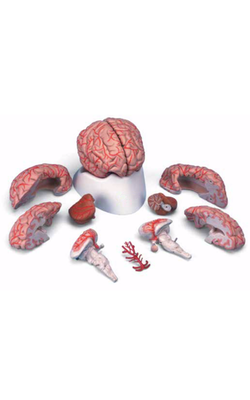Main Model

Telencephalon : 3 Occipital lobe

Brain and its Parts
The brain (contained by the neurocranium) is composed of the cerebrum, cerebellum, and brainstem. When the calvaria and dura are removed, gyri (folds), sulci (grooves), and fissures (clefts) of the cerebral cortex are visible through the delicate arachnoid-pia layer. Whereas the gyri and sulci demonstrate much variation, the other features of the brain, including overall brain size, are remarkably consistent from individual to individual.
• The cerebrum (Latin brain) includes the cerebral hemispheres and basal ganglia. The cerebral hemispheres, separated by the falx cerebri within the longitudinal cerebral fissure, are the dominant features of the brain. Each cerebral hemisphere is divided for descriptive purposes into four lobes, each of which is related to, but the boundaries of which do not correspond to, the overlying bones of the same name. From a superior view, the cerebrum is essentially divided into quarters by the median longitudinal cerebral fissure and the coronal central sulcus. The central sulcus separates the frontal lobes (anteriorly) from the parietal lobes (posteriorly). In a lateral view, these lobes lie superior to the transverse lateral sulcus and the temporal lobe inferior to it. The posteriorly placed occipital lobes are separated from the parietal and temporal lobes by the plane of the parieto-occipital sulcus, visible on the medial surface of the cerebrum in a hemisected brain. The anteriormost points of the anteriorly projecting frontal and temporal lobes are the frontal and temporal poles. The posteriormost point of the posteriorly projecting occipital lobe is the occipital pole. The hemispheres occupy the entire supratentorial cranial cavity. The frontal lobes occupy the anterior cranial fossae, the temporal lobes occupy the lateral parts of the middle cranial fossae, and the occipital lobes extend posteriorly over the tentorium cerebelli.
• The diencephalon is composed of the epithalamus, dorsal thalamus, and hypothalamus and forms the central core of the brain.
• The midbrain, the rostral part of the brainstem, lies at the junction of the middle and posterior cranial fossae. CN III and IV are associated with the midbrain.
• The pons is the part of the brainstem between the midbrain rostrally and the medulla oblongata caudally; it lies in the anterior part of the posterior cranial fossa. CN V is associated with the pons.
• The medulla oblongata (medulla) is the most caudal subdivision of the brainstem that is continuous with the spinal cord; it lies in the posterior cranial fossa. CN IX, X, and XII are associated with the medulla, whereas CN VI-VIII are associated with the junction of pons and medulla.
• The cerebellum is the large brain mass lying posterior to the pons and medulla and inferior to the posterior part of the cerebrum. It lies beneath the tentorium cerebelli in the posterior cranial fossa. It consists of two lateral hemispheres that are united by a narrow middle part, the vermis.